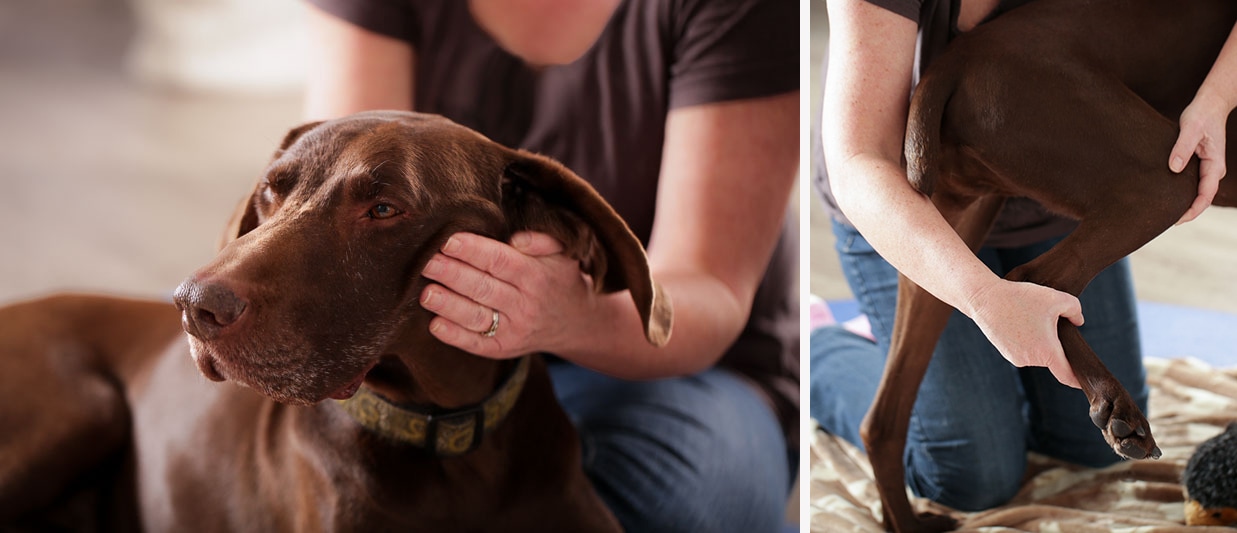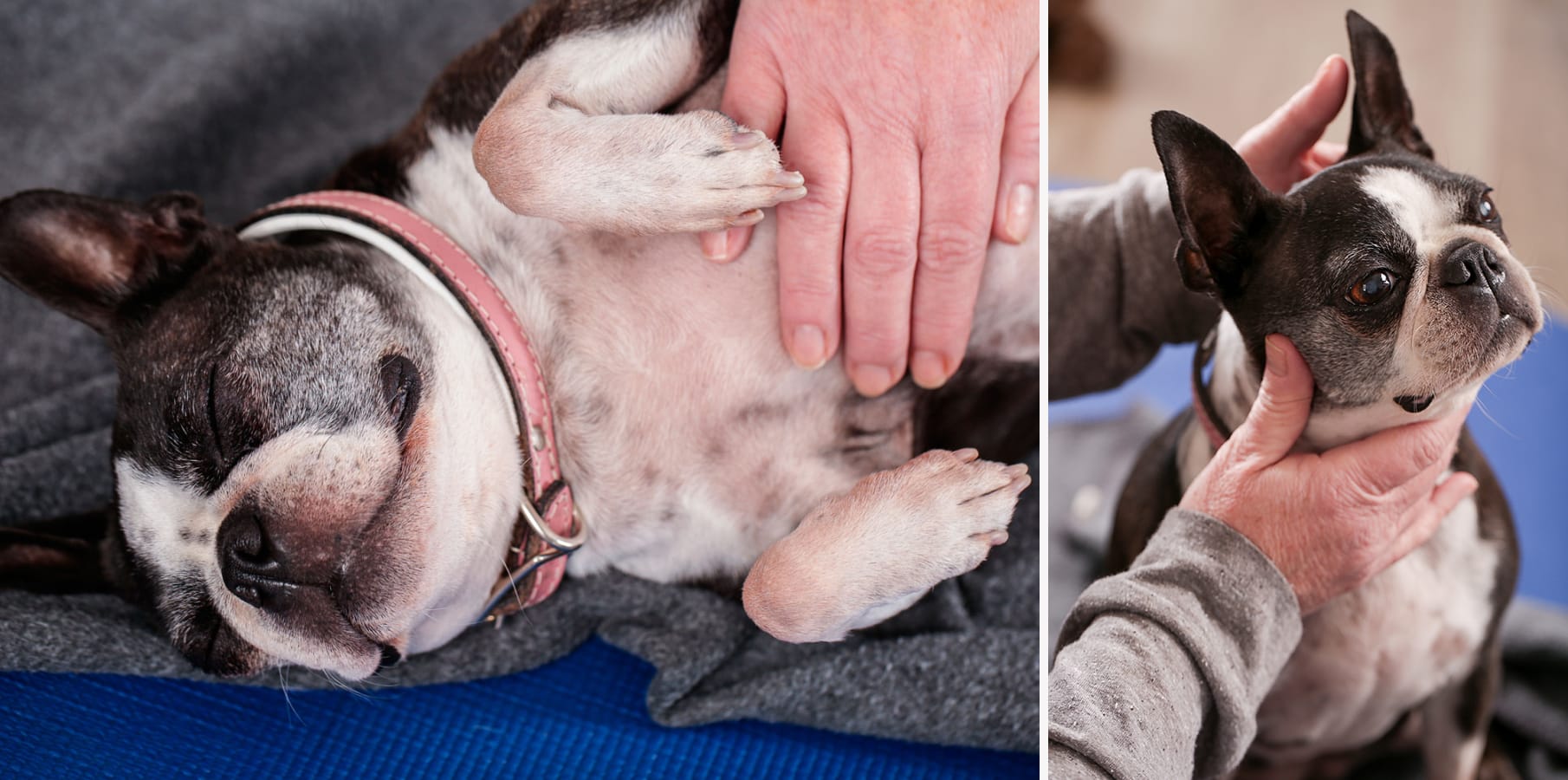It’s no surprise that since animals are such a big part of our families that people want to make sure that their faithful companions live long and healthy lives. That’s where Heather Johnston comes in. Heather is a Certified Small Animal Massage Practitioner who fully understood the benefits of canine rehabilitation and massage after her six-year-old Pointer, Blue, experienced some neurological complications following surgery and was walking with a clubbed foot. Heather discovered with regular exercise and support, over many weeks, Blue was able to regain her full mobility.
Later Heather left her corporate job and created Flow Canine Wellness in West Toronto. Today Heather partners with pet guardians to help their dogs live long and healthy lives.
You are an animal lover who grew up with both dogs and cats. What made you decide to pursue a career with dogs as the main focus as opposed to any other animal?
My initial decision to pursue animal massage came out of knowing someone doing the work. I didn't have much experience with larger animals like horses and was really drawn to dogs so it made sense to work with them. Cats don’t require the same level of support in their wellness since, as an animal, they are so much better at self-care and don't run into the same issues as dogs do. Cats regularly stretch whereas dogs will routinely sleep in the exact same position or go from a relaxed position to a very active one, like when they are awakened by a doorbell ringing. Dogs are also impacted by breeding standards that create functional issues like really long spines, short necks, or poorly distributed weight.
Was there an ‘a-ha’ moment that led you towards creating Flow Canine?
I knew that when I left the corporate world I wanted to do something very different, that I wanted to become an entrepreneur. I took some time and researched various partnership opportunities including a moving company, hair salon and franchises. Nothing fit. Then I took some time to really reflect on what I love and was passionate about. Instantly my mind went towards dogs. I looked at my education options and what type of business model made sense and then my decision was made.
Can you tell me about your education in animal massage?
In Ontario, there isn’t a regulatory body governing animal massage and no local schools are accredited. Through online research, I found a well-regarded school in Washington State where animal massage is regulated. The Northwest School of Animal Massage is accredited and offers well-regarded instruction in canine massage. The school’s founder, Lola Michelin, has over 30 years of experience in animal massage and is often called upon to offer her expertise at zoos internationally. I was privileged to have her as my instructor. Much of the program’s theory is online, but there is also intensive hands on practice required for the entry program with amazing coaching to help solidify the theory into practice. For continuing education, I gear my focus towards rehabilitative and recovery care learning. Modern technology has made it easy to network and learn through a rich online community. LinkedIn and Facebook groups provide insights, case studies, and knowledge sharing. Local training opportunities are often sponsored by breed clubs so I attend any I can.
What is your philosophy of care?
I have deep respect for my clients and draw on my knowledge of animal behaviour to listen to their input. Sometimes a client will need to get up and walk around, have a drink or just take a break. As a therapist, it’s important that the animal’s entire experience is positive so they can really benefit from the massage. It's also important for us to understand that everything that is true for humans in terms of ageing well is also true for animals. The benefits of nutrition impact us both. Think about mental state, exercise, and fresh air and how it plays into our overall health. I encourage my client’s guardians to take a holistic approach to caring for their dogs. Are you stretching or doing activities that build on the previous activities? Although dogs are robust and strong, they are also very stoic so you may not know if they have an injury. When you notice a change in your pet’s movement or behaviour it’s always a good idea to check in with your veterinarian.
What are some of the most notable benefits of animal wellness massage?
There are three major types of massage: maintenance, recovery, and performance.
In maintenance massage, we focus on the overall balance of the animal. We are looking for referring discomfort or compensation to help keep the animal balanced with healthy tissue and stretching. This is all about maintaining what you have.
When there is a surgery or acute injury, this is when we practice recovery massage. It still amounts to balance but will focus on where the surgery was and helping alleviate where they have acquired strain from compensation. With recovery massage, the pet owner will likely be assisting with strengthening exercises they should be doing at home. I spend a lot of time sharing what owners can do at home to really be a part of the recovery.
As for performance massage, it’s similar to human athletes both before and after a competition. My heart is with the senior dogs, which is why my focus has always been maintenance and recovery massage.
Why do you offer most of your massage services at the client’s home?
I made my own treatment room in my basement, but soon discovered it was more effective for the animal if they were in their own home. This is especially true for older dogs as it would allow them to relax more because they were in a familiar environment. This makes it easier to build trust with the animal and get over the existing barrier of them not knowing me. I find that animals are generally better at accepting the massage in their own environment.
How often does a pet need to receive wellness massage to see ongoing benefits?
To some degree, it depends on how much the pet's guardian is willing/able to do at home. If it’s arthritis or hip issues, but not surgery recovery massage, every other week can really make a difference. For others, a monthly massage can be helpful, but the owner will need to do more work with their pet at home. For success, there really needs to be a partnership between the pet and their owner to make a difference. When a pet is recovering from an injury treatment may be a couple of times a week at first, then bi-weekly, moving to monthly and eventually wrapping up treatment.
What can owners do at home to help increase the benefits in the days and weeks following their pet’s wellness massage?
Exercise and nutrition are really important. It's also helpful for owners to get an assessment of any potential aggravating issues in their home, particularly for senior dogs. By looking at where they spend most of their time or sleep we can help owners adjust the positioning of furniture to keep things varied. Some dogs spend all of their time every day in one position and this impacts them the same way as it does us, humans, sitting in front of a computer for many hours. Simple changes like putting in carpets on stairs or a runner down a hallway can help them when they get less coordinated as they age. Owners can move a chair around to fix a position that is causing strain. That’s something that most people don’t think of on their own.
What important life lessons has your work with animals taught you?
One of the things I learned through the schooling was the importance as a practitioner of being healthy as you enter the treatment. Making sure you’re hydrated and calm and focused. It’s also important to be in the moment. All of the practices really benefit from that. Massage is an energy process, which means you are transferring some of your energy into the animal and vice versa. I’ve never been working anywhere where my mood impacts my work so much. I had one interesting experience where I had been volunteering at a dog shelter and it had been a tricky day with an animal who was very reactive. I went to this massage and realized I was carrying some of this fear from my volunteer shift to the massage. So I didn’t charge for the session and I rebooked. It was an important reminder to be mindful of how I book my sessions so I’m not too rushed and now I don’t book after my volunteer shifts.
You grew up in Vancouver and moved to Toronto. Both are very pet prominent cities. Are there any major differences you've seen between Toronto dog owners and Vancouver dog owners?
There is a huge community of animal lovers in both cities. One might argue that Vancouver is a little more outdoor ‘healthy’ for dogs but beyond that, the passion and love for animals are the same. Both cities have great facilities to support animal health.
What are the best features the city of Toronto has to offer for dog owners?
I am amazed at how much the city has invested in off leash dog parks and facilities. High Park, Cherry Beach, Etobicoke Creek and Ashbridge’s Bay all have beautiful tracks of land available for off leash walks. There is also a growing and knowledgeable community of rewards based dog trainers and programming to educate dog walkers, boarders and pet guardians. The city just updated some of the regulations to improve the safety and wellness of dogs including regulations on tethering and a ban of choke or pronged collars.
What major changes would you like to see?
I’d like to see some mandatory education for pet owners. The body of knowledge available on dog behaviour, physiology and wellness is growing quickly. Concepts of animal behaviour like the ‘alpha dog’ are now known to be an incorrect interpretation of dog pack behaviour yet many dog owners still believe that being ‘alpha’ is the key to having a healthy relationship with their dog. I’d encourage all new pet owners to get a refresher on what the newer science is telling us about how to have a long and healthy relationship with our dogs.
What is your favourite thing about Toronto?
When I moved from Vancouver it took me two years to realize how sunny it is in Toronto. I also love the unique and vibrant neighbourhoods here; it’s really something that isn’t a part of many other cities. We’re very lucky!
To learn more about Heather and the care she offers to the canine community in Toronto visit her website here.
SM00LR





